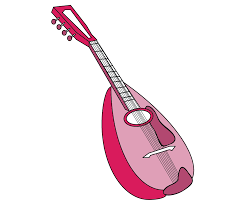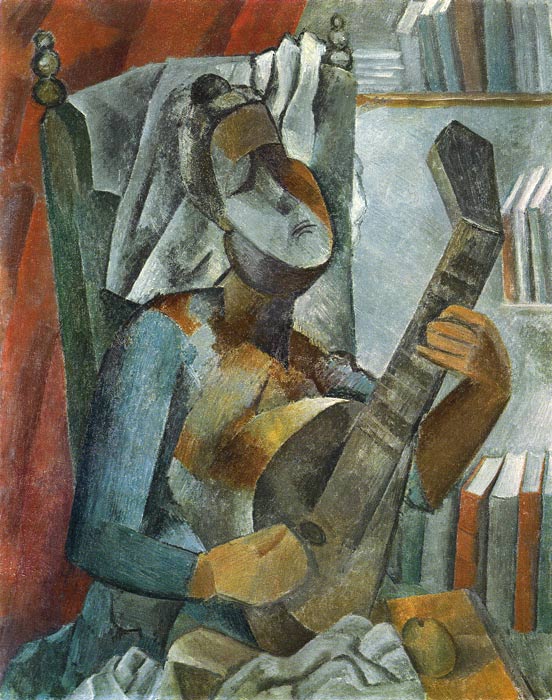"It's a very ancient saying, but a true and honest thought,
that if you become a teacher, by your pupils you'll be taught."
AUTHOR: Oscar Hammerstein II
MEANING OF THE QUOTE:
"An intelligent person knows that you can always learn
something from every situation and people you meet."
| Pierre-Auguste Renoir: Woman with a Mandolin |
Fabio Biondi, Violin and Director
Europa Galante
1. Movement: Allegro
2. Movement: Largo
3. Movement: Allegro



2. Movement: Largo
3. Movement: Allegro
| Baroque Mandolin similar to ones used during the time of Vivaldi http://www.guriema.de/k100%20en.htm |
ANOTHER VERSION:
MANDOLIN CONCERTO
C MAJOR RV. 425
C MAJOR RV. 425
Performed by Il Giardino Armonico
| William Bouguereau: Italian Mandolin |

Vivaldi's Mandolin Concerto
Movement Activity
Submitted by Daniel J. Fee, Fond du Lac, Wisconsin
Idea posted November 9, 2004
Here are some simple movements
we've done this week to the allegro from
Vivaldi's Mandolin Concerto
Idea posted November 9, 2004
Here are some simple movements
we've done this week to the allegro from
Vivaldi's Mandolin Concerto
8 step/touch to the right.
8 step/touch to the left.
8 step/touch to the left.
(Now you're back where you started.)
You stand tall, hands at your side,
and your right arm is like the hand of a clock,
ticking 8 beats up until it is straight above your head.
Holding your right hand there,
do the same 8 "ticks" with your left hand.
CLAP hands above head on beat 8.
CLAP hands above head on beat 8.
Right hand makes 4 "swirls"
as it comes down
and slaps thigh on beat four.
Repeat with left hand.
This is enough for the first section of music.
I told the students to listen for that section
to return, which it does at the end.
(At least it does in my version. I'm not sure my
(At least it does in my version. I'm not sure my
recording has the whole allegro movement.)
While waiting, we quietly kept
While waiting, we quietly kept
the steady beat in several ways.
This movement can be used to teach phrase
length and form (in addition to steady beat).
The clock part REALLY matches the music pretty well.
http://www.musick8.com/html/ideadisplay.php?ibid=1165&ideasubject=&idtextsearch=&submittedby=&group1=
The clock part REALLY matches the music pretty well.
http://www.musick8.com/html/ideadisplay.php?ibid=1165&ideasubject=&idtextsearch=&submittedby=&group1=
| Valentine Cameron Prinsep: The Mandolin Player |
OF VIVALDI'S TIME
A baroque mandolin is a lute-like instrument that has a
quiet but warm, sweet sound. Its name is probably
derived from "mandorla" (which is the word for almond
in Italian) likening the name to the shape of the
instrument. The soprano (high) mandolin is also called
a "Mandolino," a term first encountered in 1634, the
diminutive of mandola, meaning little mandola. Like
the lutes, Baroque mandolins were strung with gut
[but usually had six courses, or pairs
of gut strings (12 strings)]

quiet but warm, sweet sound. Its name is probably
derived from "mandorla" (which is the word for almond
in Italian) likening the name to the shape of the
instrument. The soprano (high) mandolin is also called
a "Mandolino," a term first encountered in 1634, the
diminutive of mandola, meaning little mandola. Like
the lutes, Baroque mandolins were strung with gut
[but usually had six courses, or pairs
of gut strings (12 strings)]
and generally plucked with the fingers (though
they were also plucked using quills) but unlike lutes,
mandolinos played mostly single-line melodies being
that they were the highest instruments in pitch,
prominent above the other instruments.
| Jean-Baptiste Camille Corot: Woman in a Toque with a Mandolin |
During Baroque times (around 1600 to 1750) the
mandolino was a relatively common instrument and
many composers wrote music for it including Vivaldi.
What Vivaldi did however, which was somewhat unique
for the times, was that he wrote concerti for the the
rather soft sounding mandolin and lute which required
them to play against string orchestras. In these concerti
he masterfully exploited the instruments' particular
qualities giving the soloists ample opportunity to show
off while retaining a proper balance with the orchestra.
This C Major Mandolin Concerto [dating from Vivaldi's
tenure at the Ospedale della Pietà (a Venetian convent
-reform school for girls), where he produced
several works for mandolin] shows this mastery; an
example being how he cleverly has the bowed strings
play pizzicato (plucking) in the first movement, actually
imitating mandolin technique.
| Baroque Violin |
Some of the oldest surviving mandolins were made
in the late 1600's. Around this time, from about 1650,
the older styled mandolins, which originally had 5 or
6 courses of double strings, began to die out with
only the soprano version, which became known as
the mandolino, being the only instrument of that group
to continued to develop. They were tuned similarly to
the violin (gg) (bb) e'e' a'a' d"d" g"g." This is the
instrument of Vivaldi's mandolin concerto. There are
still some original mandolinos surviving today from
that time period which were made by the famous
violin maker Stradivarius.
| What is a Mandolin? |
What is a Mandolin?
ARTICLE FROM:
| Carlton Alfred Smith: The Mandolin Player |
The mandolin is a chordophone (stringed) instrument
and a direct descendant of the Lute family. The
normal mandolin contains four sets (also known as
courses) of double strings tuned in fifths, and at the
same pitch as its cousin, the violin: g d' a' e." Like its
violin family cousins, the mandolin family has a
similar structure in instrumentation: mandolin (violin),
mandora or mandola (viola), mandocello (violoncello),
and the (extremely rare) mandobass (contrabass).
Each 'cousin' is tuned alike, and represents the
soprano, alto, tenor and bass ranges within their
respective group. The tones are rendered through use
of a plectrum (also known as a pick), either by single
note, strummed, or through a sustained tremolo, which
is produced by a quick vibrating movement of the
plectrum. Some Brazilian styles of mandolin playing
use the fingers in place of a plectrum, as is common
with finger-style guitar playing.
| Use of a plectrum (pick) |
Being a Lute descendant, variations of mandolin
construction have occurred over time which more
closely resemble its predecessors, with some
instruments having five double courses (Fiorentine
and Padovano mandolins), six courses (Genovese
mandolin), and four single-courses (Mandolino
Senese and Sicilian Mandolin) being the more
historically-common examples.The Mandolone, or
Arcimandola, now obsolete, carried the largest
number of courses, either seven or eight depending
on construction, but otherwise was similar in all
respects to the Neapolitan mandolin.
| Theorboed Mandolone |
The mandolin of the late 1800's to the present stem
from the Neapolitan mandolin (mandolino napolitano)
of the early Eighteenth Century. The Neapolitan
mandolin was constructed with a deeply vaulted piriform
body formed with narrow ribs of wood (colloquially
known as bowl-back or gourd-back, since the shape
favored that of a hollowed gourd) to which was connected
a fretted fingerboard neck. A pegboard set at an obtuse
angle to the neck contained the tuning machinery upon
which the strings of the instrument were wound (formerly
of catgut; now of steel wire). The strings pass over a nut
made of ivory, bone, hardwood or (in more modern times,
solid plastic), up the fretboard, across a bridge placed on
the top of the instrument, and end by being looped over
posts at the tailpiece.
Most mandolins constructed before circa
1900 were of the Neapolitan design. In 1898,
Orville Gibson was granted a patent for a new
form of mandolin whose construction more
closely favored that of the violin: the sides and
neck were carved from a single piece of wood,
with a symmetrically-carved design (eliminating
the bowl-back in favor of a shallow arch build)
which revolutionized the look, and
sound, of the mandolin.
Gibson's "A-series" mandolin
had a symmetrical
teardrop body:
while the "F-series" mandolin
augmented the teardrop design
with a scroll on the bass side of
the body and two points on the
treble side.
From 1919 to 1924, Lloyd Loar

and Guy Hart took Gibson's mandolin design one
step forward: f-style holes replaced the oval sound
holes, an additional tone bar was added (versus
one in the violin), and the fingerboard was
raised off the top of the instrument (akin to the
violin), which allows the top to resonate more
freely, providing more resonance and a larger
volume of sound. The A-style and F-style
mandolins are the instruments most often played
today by soloists and orchestras, with the
Neapolitan-style mandolins preferred by early
music and/or period instrument ensembles. The
mandolin has been used in many styles of
composition throughout time, both as a solo
instrument and in ensemble.
| Vekoslav Karas: Young Woman with a Mandolin |
In Classical writings, it is found in compositions by
Vivaldi and Hummel (numerous concerti for mandolin
and orchestra), Handel (Alexander Balus oratorio),
Paesiello (Il Barbiero de Sevilla), Mozart (Don Giovanni),
Verdi (Otello), Beethoven (various Sonatas for Mandolin
and Piano), Mahler (Symphony Number Seven),
Stravinsky (Agon), among other composers and
compositions in musical literature.
 |
| Don Giovanni serenading with a mandolin in Mozart's opera, 1787 |
Folk music has drawn the mandolin into its fold very
easily. From music of the British Isles to North
American Appalachia to South America and beyond,
with particular favorites found in reels, jigs, and other
assorted tunes, the combination of the mandolin with
violin, guitar, acoustic/upright bass and occasional
vocals has provided musical comfort unique unto
itself from the middle of the Twentieth Century forward;
with bluegrass -- and the foundations laid by
mandolinist Bill Monroe (1911-1996) -- being the
pinnacle of the genre. Jazz, Rock, New Age, and other
musical styles have incorporated the mandolin in
varying ways with success.

With the advent of the Twentieth Century, and the
surge of immigration in America, mandolin orchestras
grew in popularity. Many towns featured "mandolin
clubs," where local talent gathered to play waltzes,
parlor songs, college songs, light classical music,
marches, ragtime and other popular music of the day.
These clubs, particularly in larger metropolitan areas,
grew in size and membership, forming full-fledged
mandolin orchestras, which featured the members of
the mandolin family, in addition to guitar, bass, and
occasional other instruments as the local talent pools
had readily available. After World War One, however,
and the rise of Jazz and Big Band/Swing, the
mandolin faded from the limelight. Most of the
mandolin orchestras of the era retired into the pages
of history...but not all.
| Mandolin Orchestra Instruments |
Some of the more long-standing organizations to survive
the changes over time include: The New York Mandolin
Orchestra, one of the oldest continually performing
orchestras in America, which celebrated their eightieth
anniversary in June, 2004; The Sydney (Australia)
Mandolin Orchestra, founded in 1932; the Bloomfield
(New Jersey) Mandolin Orchestra, founded in 1942.
 |
| New York Mandolin Orchestra It was originally named the New York Freiheit Mandolin Orchestra |
Pablo Picasso Woman Playing on Mandolin (left) and
Girl with a Mandolin, 1910 (right)
LINKS
| Berthe Morisot: The Mandolin |
http://www.mandolinserenade.com/hist.html
http://www.lyrabaroque.org/events/archive/2001mandolin.html
http://www.niteq.nl/amoreille/wb/pages/uk/instruments/baroque-mandolin.php
http://www.mandolinluthier.com/history.htm
http://daytonmandolin.net/Mandolins.html
http://www.themandolintuner.com/mandolin-types-and-history/
http://xenon.stanford.edu/~geksiong/music/Mandolin%20Concerto%20in%20C%20major%20RV425.pdf
http://www.vivaldifestival.com/audio&video5englishmenuamoroso.htm
http://www.lyrabaroque.org/events/archive/2001mandolin.html
http://www.niteq.nl/amoreille/wb/pages/uk/instruments/baroque-mandolin.php
http://www.mandolinluthier.com/history.htm
http://daytonmandolin.net/Mandolins.html
http://www.themandolintuner.com/mandolin-types-and-history/
http://xenon.stanford.edu/~geksiong/music/Mandolin%20Concerto%20in%20C%20major%20RV425.pdf
http://www.vivaldifestival.com/audio&video5englishmenuamoroso.htm
| Henri Matisse: Woman with Mandolin |
| Paul Gauguin: Mandolin on a Chair |
| Benjamin West: Mary Hopkinson (with Mandolin), c.1764 |

